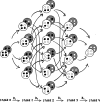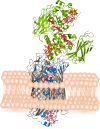Electron transfer in multicentre redox proteins: from fundamentals to extracellular electron transfer
- PMID: 39714013
- PMCID: PMC12203936
- DOI: 10.1042/BSR20240576
Electron transfer in multicentre redox proteins: from fundamentals to extracellular electron transfer
Abstract
Multicentre redox proteins participate in diverse metabolic processes, such as redox shuttling, multielectron catalysis, or long-distance electron conduction. The detail in which these processes can be analysed depends on the capacity of experimental methods to discriminate the multiple microstates that can be populated while the protein changes from the fully reduced to the fully oxidized state. The population of each state depends on the redox potential of the individual centres and on the magnitude of the interactions between the individual redox centres and their neighbours. It also depends on the interactions with binding sites for other ligands, such as protons, giving origin to the redox-Bohr effect. Modelling strategies that match the capacity of experimental methods to discriminate the contributions of individual centres are presented. These models provide thermodynamic and kinetic characterization of multicentre redox proteins. The current state of the art in the characterization of multicentre redox proteins is illustrated using the case of multiheme cytochromes involved in the process of extracellular electron transfer. In this new frontier of biological electron transfer, which can extend over distances that exceed the size of the individual multicentre redox proteins by orders of magnitude, current experimental data are still unable, in most cases, to provide discrimination between incoherent conduction by heme orbitals and coherent band conduction.
© 2025 The Author(s).
Conflict of interest statement
The authors declare no conflict of interests.
Figures







Similar articles
-
Short-Term Memory Impairment.2024 Jun 8. In: StatPearls [Internet]. Treasure Island (FL): StatPearls Publishing; 2025 Jan–. 2024 Jun 8. In: StatPearls [Internet]. Treasure Island (FL): StatPearls Publishing; 2025 Jan–. PMID: 31424720 Free Books & Documents.
-
Sexual Harassment and Prevention Training.2024 Mar 29. In: StatPearls [Internet]. Treasure Island (FL): StatPearls Publishing; 2025 Jan–. 2024 Mar 29. In: StatPearls [Internet]. Treasure Island (FL): StatPearls Publishing; 2025 Jan–. PMID: 36508513 Free Books & Documents.
-
The Black Book of Psychotropic Dosing and Monitoring.Psychopharmacol Bull. 2024 Jul 8;54(3):8-59. Psychopharmacol Bull. 2024. PMID: 38993656 Free PMC article. Review.
-
Cost-effectiveness of using prognostic information to select women with breast cancer for adjuvant systemic therapy.Health Technol Assess. 2006 Sep;10(34):iii-iv, ix-xi, 1-204. doi: 10.3310/hta10340. Health Technol Assess. 2006. PMID: 16959170
-
Signs and symptoms to determine if a patient presenting in primary care or hospital outpatient settings has COVID-19.Cochrane Database Syst Rev. 2022 May 20;5(5):CD013665. doi: 10.1002/14651858.CD013665.pub3. Cochrane Database Syst Rev. 2022. PMID: 35593186 Free PMC article.
Cited by
-
Redox partner exchanges between spatially confined complexes control the coupling effect of cytochrome b5 on P450 CYP3A4.Sci Rep. 2025 Jul 9;15(1):24584. doi: 10.1038/s41598-025-09060-5. Sci Rep. 2025. PMID: 40628863 Free PMC article.
References
-
- Kim Y., Logan B.E. Microbial desalination cells for energy production and desalination. Desal. 2013;308:122–130. doi: 10.1016/j.desal.2012.07.022. - DOI
-
- Al-Mamun A., Ahmed W., Jafary T., Nayak J.K., Al-Nuaimi A., Sana A. Recent advances in microbial electrosynthesis system: metabolic investigation and process optimization. Biochem. Eng. J. 2023;196:108928. doi: 10.1016/j.bej.2023.108928. - DOI
Publication types
MeSH terms
Substances
LinkOut - more resources
Full Text Sources

